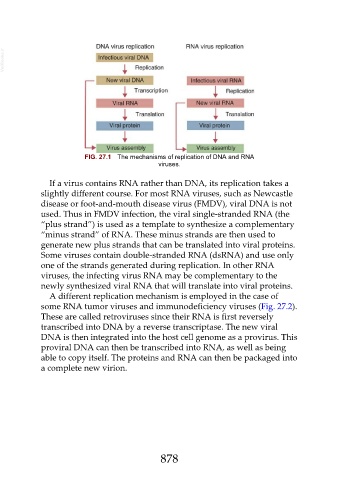Page 878 - Veterinary Immunology, 10th Edition
P. 878
VetBooks.ir
FIG. 27.1 The mechanisms of replication of DNA and RNA
viruses.
If a virus contains RNA rather than DNA, its replication takes a
slightly different course. For most RNA viruses, such as Newcastle
disease or foot-and-mouth disease virus (FMDV), viral DNA is not
used. Thus in FMDV infection, the viral single-stranded RNA (the
“plus strand”) is used as a template to synthesize a complementary
“minus strand” of RNA. These minus strands are then used to
generate new plus strands that can be translated into viral proteins.
Some viruses contain double-stranded RNA (dsRNA) and use only
one of the strands generated during replication. In other RNA
viruses, the infecting virus RNA may be complementary to the
newly synthesized viral RNA that will translate into viral proteins.
A different replication mechanism is employed in the case of
some RNA tumor viruses and immunodeficiency viruses (Fig. 27.2).
These are called retroviruses since their RNA is first reversely
transcribed into DNA by a reverse transcriptase. The new viral
DNA is then integrated into the host cell genome as a provirus. This
proviral DNA can then be transcribed into RNA, as well as being
able to copy itself. The proteins and RNA can then be packaged into
a complete new virion.
878

